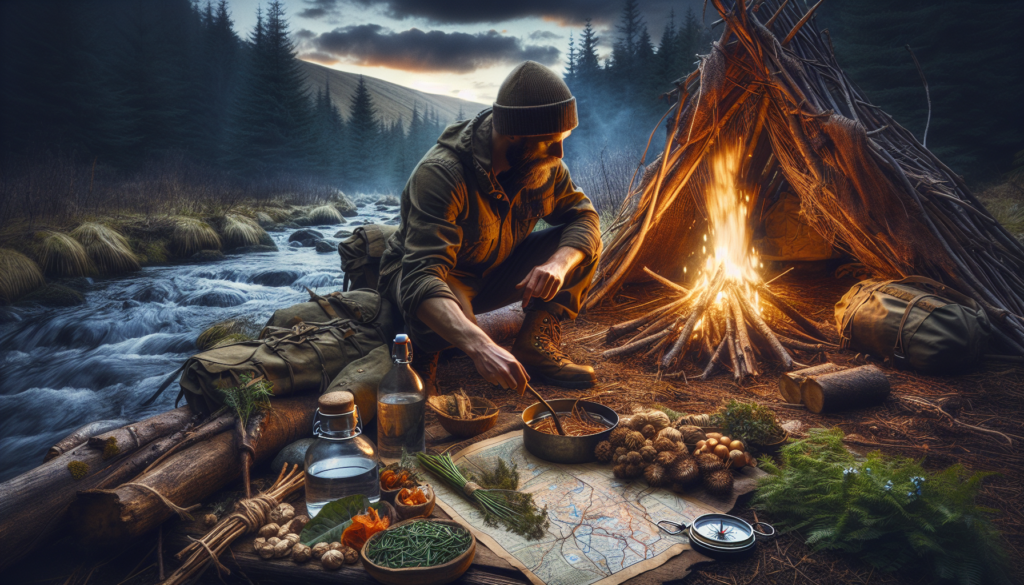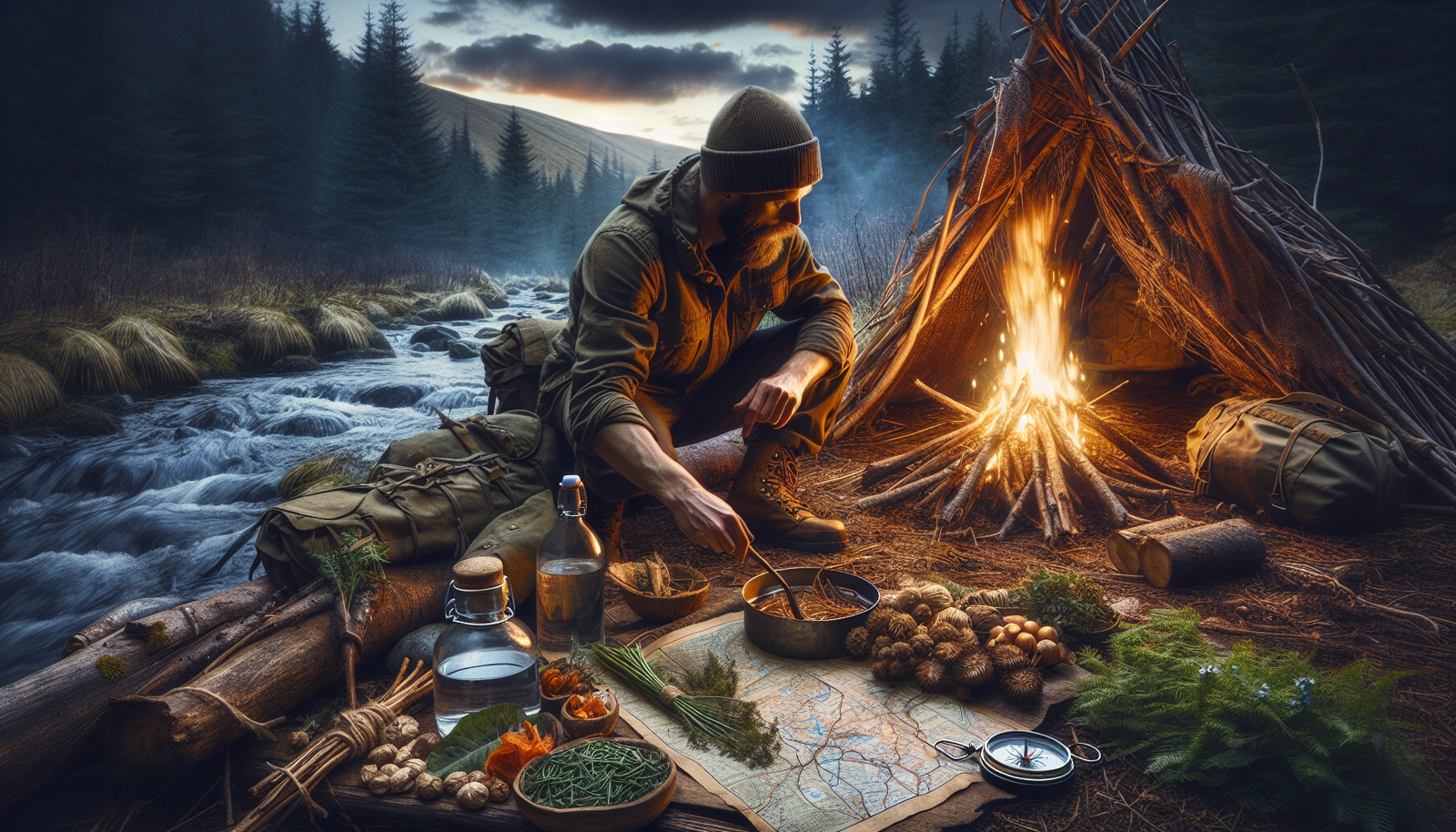In “Surviving in the Wilderness: A Beginner’s Guide,” you’ll discover an invaluable resource that offers practical tips and knowledge for navigating the great outdoors with confidence. Whether you’re a curious beginner or preparing for extreme situations, this guide covers essential survival skills, from building shelters and finding food and water to staying warm and signaling for help. With a focus on empowering individuals to become self-reliant and resilient in the face of adversity, this guide ensures that you’re equipped to overcome challenges and emerge stronger. So, if you’re ready to feel prepared for life’s unpredictable twists or embark on an outdoor adventure, this guide is the perfect companion for you.
Surviving in the Wilderness: A Beginner’s Guide
In a world where unexpected situations can arise, mastering basic survival skills offers peace of mind and the potential to save lives. These skills are crucial for anyone venturing into the wilderness, whether it’s for a thrilling outdoor adventure or as a precautionary measure for life’s unpredictable twists. This beginner’s guide aims to provide you with comprehensive knowledge and practical tips to help you survive and thrive in the wilderness, even if you have no prior experience. Let’s dive in!

Section 1: Getting Started
Understanding the Wilderness
Before diving into wilderness survival, it’s essential to understand the environment you’ll be facing. The wilderness is a diverse and often challenging landscape, filled with potential risks and rewards. It encompasses various terrains, such as forests, mountains, deserts, and coastal areas, each with its unique set of challenges. Familiarize yourself with the region you’ll be exploring, including its climate, typical wildlife, and vegetation. This knowledge will help you make informed decisions and adapt to the wilderness effectively.
Assessing the Risks
Surviving in the wilderness involves recognizing and managing potential risks. Evaluate the environmental hazards you might encounter, including extreme weather conditions, dangerous wildlife, and inaccessible terrains. Additionally, consider any personal factors, such as medical conditions or allergies, that could affect your ability to cope in the wilderness. By assessing the risks beforehand, you can prepare adequately and take necessary precautions to ensure your safety.
Building a Survival Kit
A well-prepared survival kit is an essential tool for any wilderness adventure. It should contain items that will assist you in various survival scenarios. Your survival kit should include:
- Navigation tools: A compass, map, and GPS device.
- Shelter: Lightweight tent or tarp, sleeping bag, and blankets.
- Water and purification: Water bottles or reservoirs, water filter or purification tablets.
- Fire-starting tools: Waterproof matches, lighter, and firestarter.
- First aid supplies: Bandages, antiseptic ointment, pain relievers, and any necessary prescription medications.
- Cutting tools: Knife, multi-tool, and a small folding saw.
- Food: High-energy non-perishable snacks like protein bars, nuts, and dried fruits.
- Signaling equipment: Whistle, mirror, and a brightly colored flag.
- Clothing and protection: Extra layers, rain gear, hat, gloves, and sunglasses.
- Basic tools: Paracord, duct tape, and a small shovel.
Pack your survival kit in a waterproof container or bag and always carry it with you when venturing into the wilderness. Remember to familiarize yourself with the contents of your kit and practice using the tools before you need them.
Section 2: Shelter and Campsite
Choosing a Suitable Campsite
Selecting the right campsite is crucial for your safety and comfort in the wilderness. Look for an area that is level, dry, and sheltered from the wind. Consider nearby natural features, such as cliffs or large rocks, which can provide additional protection. Avoid camping in low-lying areas prone to flooding. If possible, choose a spot close to a water source but ensure it is at a safe distance to prevent contamination.
Building a Shelter
Having a reliable shelter protects you from the elements and provides a sense of security in the wilderness. Depending on the materials available, you can choose to build a variety of shelters, such as a lean-to, debris hut, or tarp shelter. Learn the basics of constructing these shelters and practice building them in different environments before your wilderness adventure. Remember to insulate the shelter with natural materials like leaves or pine needles to retain warmth.
Campsite Maintenance
Maintaining your campsite is essential to minimize your impact on the environment and prevent unwanted encounters with wildlife. Always leave your campsite cleaner than you found it, disposing of waste properly and packing out any trash. Store food securely in airtight containers or hang it from a tree branch to prevent attracting animals. Follow Leave No Trace principles, which promote responsible outdoor practices, to preserve the wilderness for future generations.
Section 3: Finding Water
Importance of Water in Survival
Water is essential for survival, and knowing how to find and purify it is critical in the wilderness. Your body can only survive for a few days without water, so it’s vital to prioritize hydration. Dehydration can lead to fatigue, confusion, and even life-threatening conditions. Always carry a sufficient supply of water and be prepared to find additional sources in the wilderness.
Locating Water Sources
To find water in the wilderness, look for signs such as vegetation, animal tracks, or low-lying areas. Streams, rivers, and lakes are excellent natural water sources, but be cautious of their quality. If these sources are unavailable, you can collect dew or rainwater, dig for groundwater, or melt snow or ice. Carry a water filter or purification tablets to treat water from questionable sources, ensuring it’s safe to drink.
Purifying Water
Purifying water is crucial to remove harmful bacteria, parasites, and other contaminants. Several methods can be used to purify water in the wilderness, including boiling, chemical treatment, and filtration. Boiling water is the most reliable method, as it kills most microorganisms. However, chemical treatments, such as iodine or chlorine tablets, and portable water filters can also effectively purify water. Understand the pros and cons of each purification method and carry appropriate tools in your survival kit.
Section 4: Obtaining Food
Foraging for Edible Plants
Foraging for edible plants can provide you with an additional food source in the wilderness. However, it requires knowledge and caution, as not all plants are safe to eat. Familiarize yourself with edible plant species in the region you’ll be exploring, and learn to identify them accurately. Never consume a plant unless you are 100% certain of its safety. Additionally, remember to practice sustainable foraging practices and avoid over-harvesting to preserve the ecosystem.
Hunting and Fishing
Hunting and fishing techniques can help you obtain animal protein in the wilderness. Before venturing into these activities, research local hunting and fishing regulations to ensure compliance. Learn basic skills such as setting traps, constructing snares, or using a fishing rod. Carry appropriate gear, such as a hunting knife, fishing line, and hooks, in your survival kit. However, it’s important to remember that hunting and fishing require skills, knowledge, and often appropriate permits, so be prepared and responsible.
Trapping Techniques
Trapping is another method to acquire food in the wilderness. Traps can be set to capture small game, such as rabbits or squirrels. Research and practice different trap designs, such as deadfalls or snare traps, to increase your chances of success. Always prioritize the humane treatment of animals and release any non-target species promptly. Remember that trapping might not be legal in some areas or during certain seasons, so familiarize yourself with local regulations.

Section 5: Navigating in the Wilderness
Using a Compass
Navigating with a compass is an essential skill in the wilderness. A compass helps you determine your direction and navigate towards a specific location. Learn how to read a compass and understand concepts like cardinal directions, bearings, and declination. Practice using a compass in different environments before relying on it during your wilderness adventure. Always carry a map and a compass as backup and ensure you know how to use both effectively.
Reading Maps and Landmarks
Reading maps and identifying landmarks are fundamental skills to guide yourself in the wilderness. Topographic maps provide valuable information about the terrain, elevation, and surrounding features. Learn how to interpret contour lines, scale, and symbols on a map. Familiarize yourself with prominent landmarks such as mountains, rivers, or distinctive geological formations that can serve as reference points. Regularly update your map with your location as you navigate through the wilderness.
Navigating without Tools
In case you find yourself without navigation tools, it is still possible to find your way in the wilderness. Observe natural features like the sun, moon, or stars to determine your direction. Pay attention to recurring patterns in the landscape, such as rivers or mountain ranges, which can guide you. Learn to track your own footsteps and backtrack if necessary. Developing these natural navigation skills increases your self-reliance and helps you stay on course.
Section 6: Firecraft
The Importance of Fire in Survival
Fire is not only a source of warmth but also crucial for cooking food, boiling water, and signaling for help in the wilderness. Understanding firecraft is essential for your survival skills. Learn about the different types of fire and their purposes, such as teepee fire, log cabin fire, or lean-to fire. Practice building fires using different fire-starting methods, including matches, lighters, and primitive techniques like friction fire. Always prioritize safety and ensure your fire is adequately extinguished before leaving it.
Building a Fire
Building a fire requires proper materials and techniques. Collect tinder, kindling, and fuel wood before starting your fire. Tinder is small and highly flammable material, such as dry grass or wood shavings. Kindling consists of slightly larger sticks, while fuel wood provides a sustained source of heat. Arrange the materials in a teepee or log cabin shape, allowing air to flow through for ventilation. Ignite the tinder and gradually add larger materials to build a strong and lasting fire.
Fire Starting Techniques
In addition to matches and lighters, it’s essential to learn primitive fire-starting techniques as a backup. These techniques include using a fire bow drill, hand drill, or flint and steel. Each method requires practice and skill, so devote time to master these techniques before relying on them in the wilderness. Carry a fire-starting tool, such as a magnifying glass or ferrocerium rod, in your survival kit as an additional fire-starting method.
Section 7: Staying Warm
Understanding Hypothermia
Hypothermia is a life-threatening condition caused by prolonged exposure to cold temperatures. Knowing how to stay warm and recognizing the signs of hypothermia is crucial in the wilderness. Dress in layers to trap heat and insulate your body. Avoid sweating, as wet clothing loses insulation properties. Set up a well-insulated shelter and avoid direct contact with the cold ground. Consume high-energy foods to maintain your body’s heat production. If someone shows signs of hypothermia, take immediate action and provide warmth and shelter.
Building Insulated Clothing
In extreme cold conditions, it may be necessary to create additional insulation for your clothing. Use natural materials, such as leaves, moss, or dry grass, to stuff your clothing layers and retain heat. This improvised insulation can provide essential warmth, especially in emergency situations. Remember that it’s essential to avoid compressing the insulation, as it reduces its effectiveness.
Creating a Warm Bed
A warm bed is essential for sleeping comfortably and maintaining body heat in the wilderness. Construct a bed using natural materials like leaves, pine needles, or dry grass. These materials create a layer of insulation between you and the cold ground. A well-built bed can greatly improve your quality of sleep and contribute to your overall well-being in the wilderness.
Section 8: First Aid and Medical Considerations
Basic First Aid Skills
Having basic first aid skills can save lives in emergency situations. Learn how to assess and treat common injuries like cuts, burns, sprains, and fractures. Familiarize yourself with CPR and other life-saving techniques. Attend first aid courses or workshops to gain practical experience and confidence in administering emergency care. Develop a first aid kit tailored to your needs and ensure it contains essential items like bandages, antiseptics, and pain relievers.
Identifying and Treating Common Injuries
Recognizing and properly treating common wilderness injuries is essential for your well-being. Learn to identify and address issues like sprained ankles, blisters, snake bites, and allergic reactions. Carry any necessary medication, such as epinephrine for severe allergies, and understand how to use it correctly. Prioritize hygiene to prevent infections, and keep wounds clean and covered. Finally, be prepared to deal with emergencies and know when to seek professional medical help.
Emergency Medical Tips
In wilderness survival, it’s crucial to be equipped with emergency medical knowledge. Learn how to manage life-threatening situations like severe bleeding, choking, or a heart attack. Understand how to stabilize an injured person, create makeshift splints, and perform improvised rescue techniques. Develop a communication plan to contact emergency services and know the relevant emergency numbers for the area you’re exploring. Remember that in the wilderness, your first aid skills may be the difference between life and death, so be well-prepared.
Section 10: Mental Preparedness
Maintaining a Positive Mindset
Surviving in the wilderness requires mental resilience. Maintaining a positive mindset can make a significant difference in your ability to cope with challenging situations. Stay optimistic and focus on the tasks at hand. Cultivate gratitude for the resources and skills at your disposal. Keep a journal to document your experiences and reflect on the positives. Surround yourself with supportive and like-minded individuals to boost morale and motivation.
Coping with Stress and Anxiety
The wilderness can be an unpredictable and demanding environment, often leading to stress and anxiety. Develop coping mechanisms to manage these emotions effectively. Breathing exercises, meditation, and focusing on the present moment can alleviate stress. Engage in activities that bring you joy and take time to appreciate the beauty of nature. Stay connected with loved ones through communication devices to seek emotional support when needed.
Building Resilience
Building resilience is essential for long-term survival in the wilderness. Embrace challenges as opportunities for growth and learning. Learn from your mistakes and adapt your strategies accordingly. Practice problem-solving and decision-making skills in various scenarios. Recognize that setbacks are normal and part of the journey. By developing resilience, you become better equipped to overcome adversity and emerge stronger from wilderness experiences.
By following this beginner’s guide to surviving in the wilderness, even with no prior experience, you’ll gain the essential knowledge and skills to navigate and thrive in the unpredictable outdoors. Remember to always prioritize safety, acquire practical skills through training and practice, and respect the natural environment. By equipping yourself with the necessary survival skills, you’ll embrace the wilderness with confidence and emerge from any challenge stronger than ever before.

